Bread 2006 (April to August)
After the Sprouted Wheat Bread adventure, I did continue to bake breads at a steady pace (weekly, pretty much). We had a few repeated breads, but I tried to balance the repeats with some new recipes.
Here are the breads I made from April to August of last year.
The first is called Buttermilk Cheese Bread, containing – you got it! – buttermilk and sharp cheddar cheese.
After the first rising, the bread dough is formed into a loaf and placed in a loaf pan:

Here’s the bread after it has been baked:
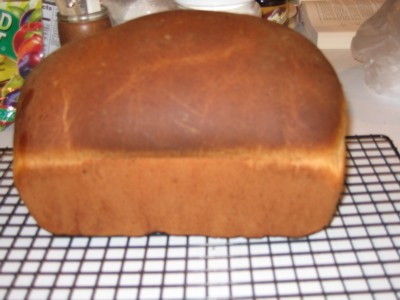
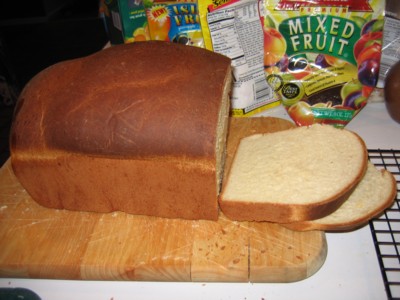

The Buttermilk Cheese bread was quite cheesy, and the texture was very nice and fluffy. Quite an enjoyable bread, had a nice tang from both the buttermilk and the sharp cheddar cheese.
Next, I decided to experiment with brioche. Brioche is a french bread that has a high butter content. The butter content is so high that after the dough has been kneaded, it actually has to be chilled for 4 hours (or overnight) before you can work it. Otherwise, the dough is very sticky. In fact, if you work the dough too much after it’s been chilled, it might start to warm up and get sticky again. In which case, you have to stick it back in the fridge until the butter is firmed up and with it, the dough.
So, after the dough has been refrigerated overnight, divide the dough in half. Half of this dough will be made into Croissant Brioche (brioche bread but shaped into the crescent shape that gives the croissant its name).
First, roll out the dough. (This is a bit of a race against time – have to work quickly so the butter doesn’t warm up too much and make the dough stick to the work surface. Also I tried not to handle the dough too much with my bare hands to avoid warming the butter up with body heat).

Cut the dough into 8 pieces:
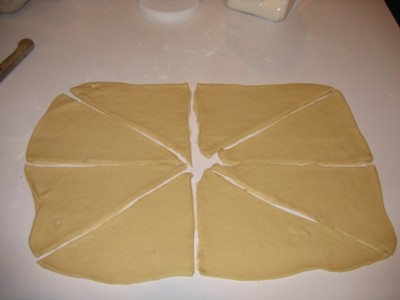
Form the crescents by rolling from the wide section to the narrow:
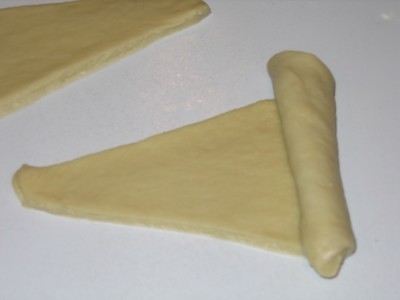
Bend the rolled dough ends:
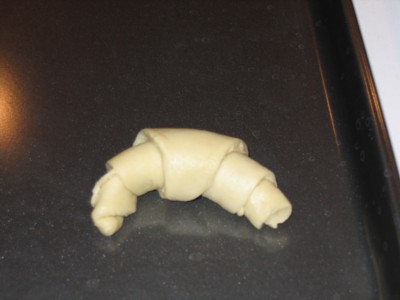
Make a whole tray of it:
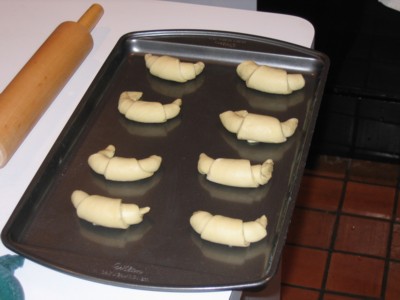
Let the dough rise, then bake. After a turn in the oven, here’s what we get:
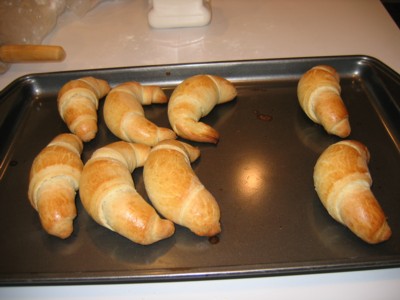
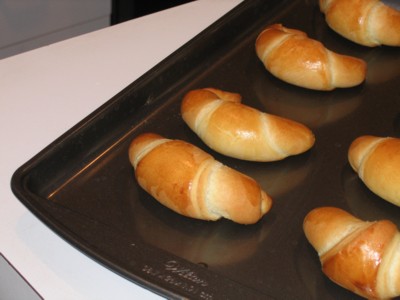
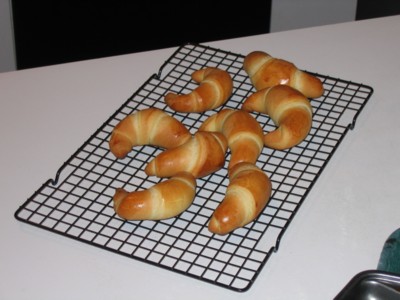
It’s rich and very tasty. Don’t get this mixed up with the regular croissant bread. A croissant also has very high butter content like the brioche. But unlike the brioche, the dough and the butter is rolled in many many layers so that when it is baked, the croissant comes out flaky, like a pastry. I haven’t dared to try making croissants myself as it is a big production and seems like a lot of rolling before the payoff. One of these days, I will attempt the real croissant. But not today!
Half of the dough has been rolled out to make 16 croissant rolls. The other half, I decided to try one of the easier brioche patterns described in the book. This is called the Le Havre Brioche.
Roll the dough into 6 balls (again moving quickly so the butter doesn’t warm up and get the dough sticky). Place the balls in a zigzag pattern in a loaf pan:
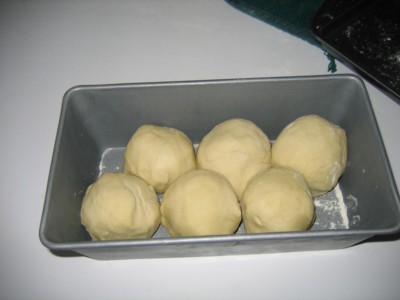
Allow the dough to rise.
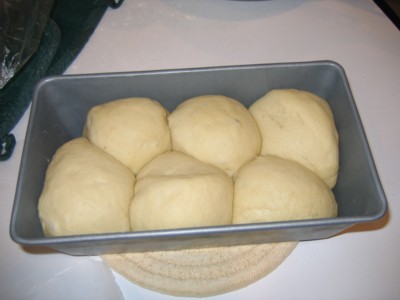
Then bake:

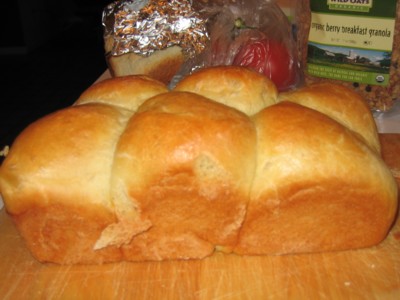
And my favorite shots, the bread is sliced:
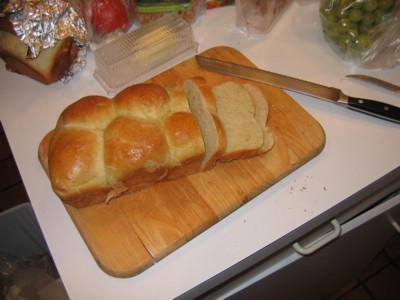
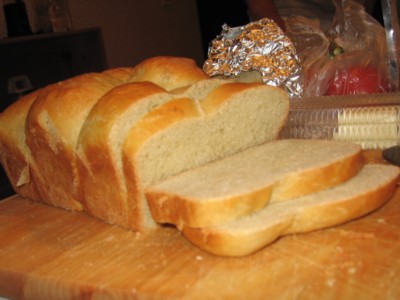
This was a really nice bread – perfect for sandwiches. Not to mention, it makes a beautiful toast.
Onion Rye was the next bread I tried. As indicated by its name, this bread was made with rye flour and contains almost a cup of chopped onions. There’s also caraway seeds in this dough which gives it a depth of flavor that was quite unexpectedly nice.

Allow the loaf to rise:
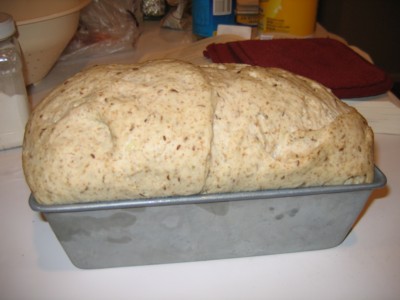
Bake that puppy:
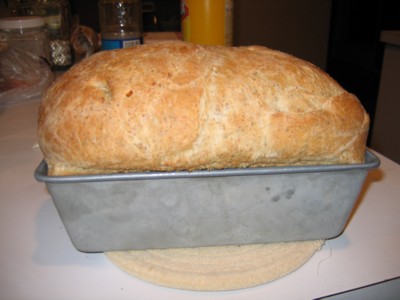
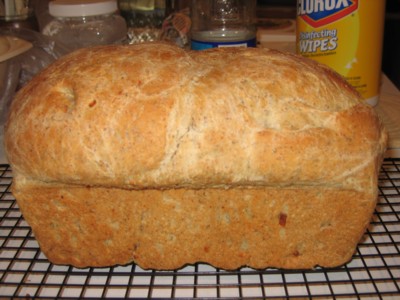
And of course, sliced:
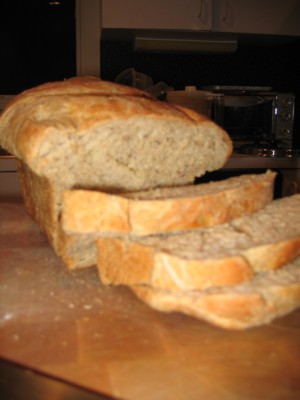

It had a beautifully fluffy texture, and the crust was nice and crusty. Not to mention it smelled wonderful while it was baking! The onions and caraway really made this bread.
Next I tried my hand at making pita bread. It was a little bit hard to control as my main oven was on the fritz and I had to use the secondary oven (which is normally what I use to control the temperature of the dough during risings). Partly due to the fact that I don’t know this oven as well as the primary fritzing oven, I kept burning the pita. It came out hard and almost crackerlike!
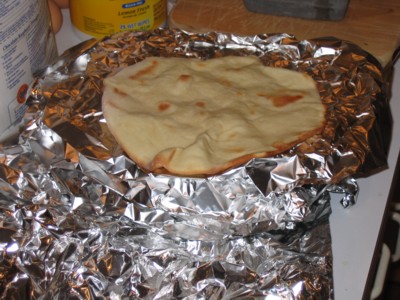
I salvaged the bread by covering the crackerlike bread with a wet cloth overnight – it absorbed the liquid and ended up being soft and pliable, like pita bread is supposed to be. And to go with it, I made gyro meat with ground lamb and spices:
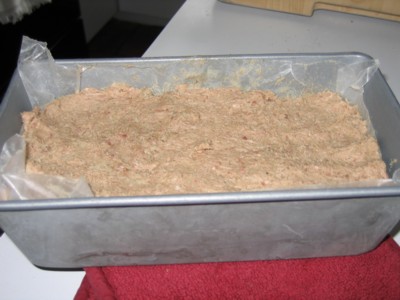
Assemble the gyro sandwich by putting slices of the lamb meat on the pita bread. Sprinkle with onions:

Top with traditional tzatziki sauce made with yogurt, garlic, cucumber and spices:

Then fold up and eat! Traditionally, you could garnish with tomatoes as well, but I don’t like tomatoes so we omitted them from our gyro sandwiches.
Next, we return to cheese bread. This is called the Twisted Cheese Loaf. This loaf contains 8 ounces of slized Swiss cheese, and 8 ounches of natural Swiss cheese, cubed.After the dough goes through its first rising, roll the dough out.
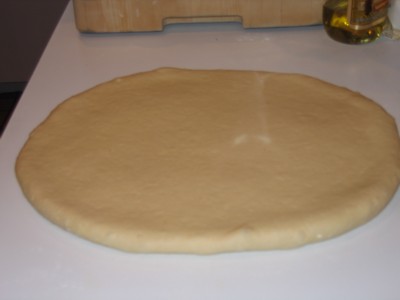
Cut into 3 strips, but don’t cut all the way. Keep the dough connected at one end:
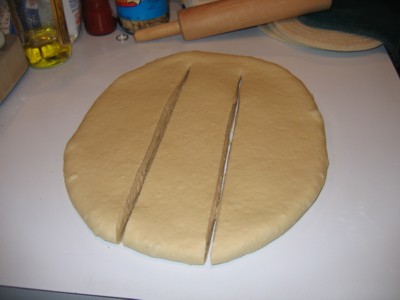
Braid the strips (this is the twist part of the dough) and place into a loaf pan:
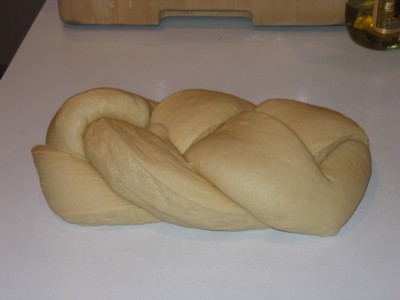
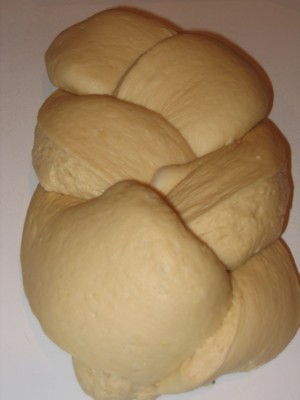
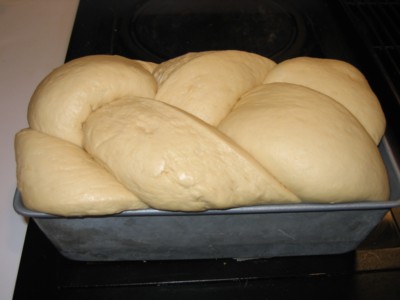
After a second rising, bake the bread:
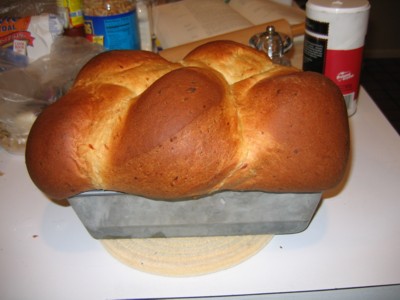
And here’s the sad part. The loaf fell to the side when removed from the loaf pan! Argh! I tried to put it back in the loaf pan to see if it would harden up ok, but look at this shot of the loaf from the top – you can see that the twists are all askew:
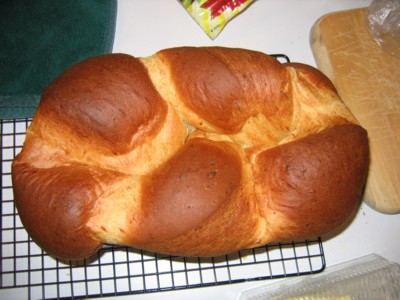
Then I gave up and said, ok, the bread fell over. Here are shots of the bread after it is sliced:
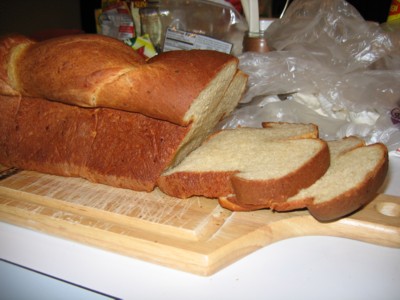
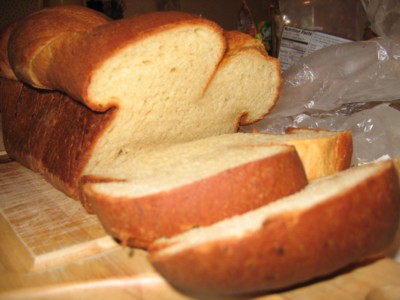
The good thing is that even though the bread fell over like that, Vin very much enjoyed this very cheesy bread. Maybe next time I will divide the dough into 2 separate loafs and make 2 smaller loaves so that it can stand up without falling over.
And finally, this is called Savory Herb bread. Make the bread dough and while it goes through its first rising, I make the savory filling which is chopped garlic, soft butter and some dried herbs.
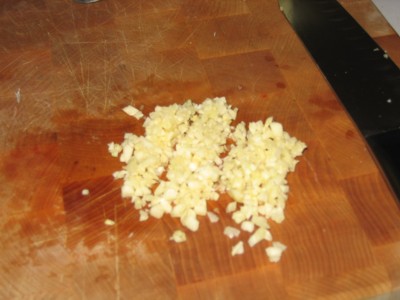
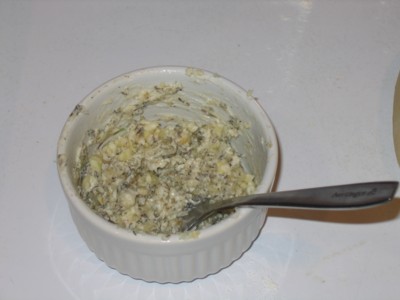
Here’s the dough after its first rising:
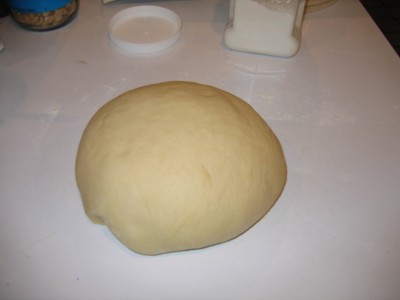
Roll out the dough into a large rectangle:
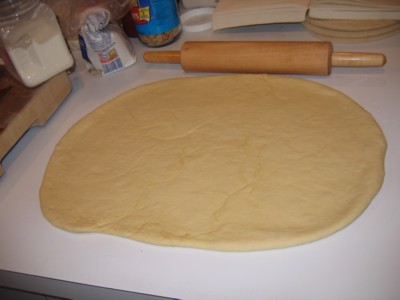
Spread the butter, garlic and herb mixture all over the dough:
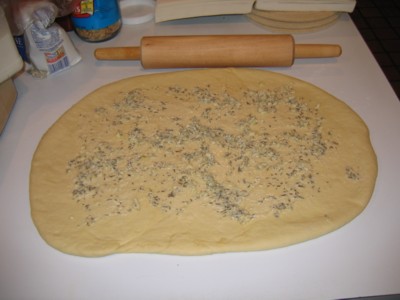
Roll it up, pinch the seams and place on a cookie sheet:
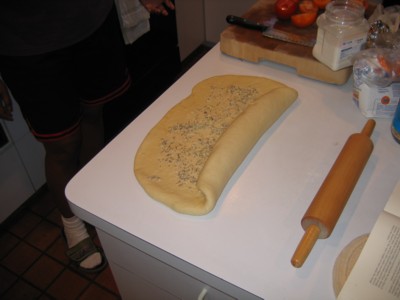
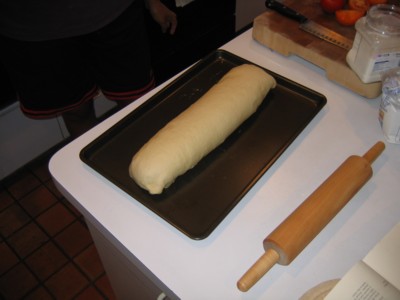
Let the dough rise again:
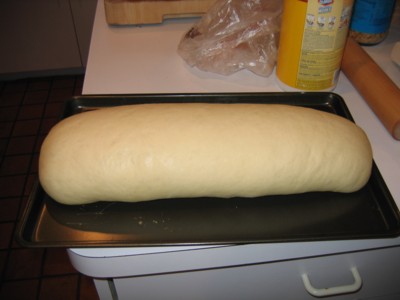
Bake it up:
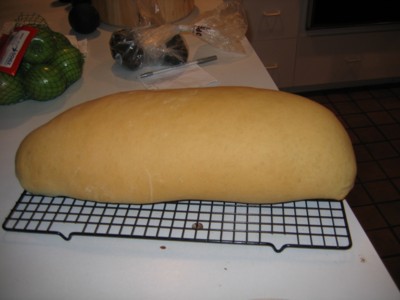
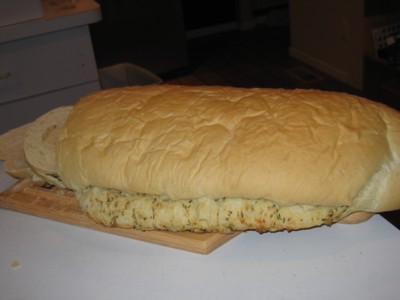
Then of course, time to slice and eat this bread:
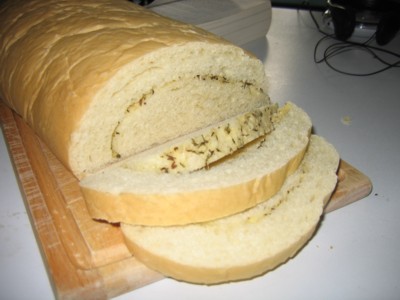
This was gorgeous – plus it made a good party bread to be brought to dinners and eaten dipped in olive oil. Lovely!
That’s all the different breads that I experimented with last year between April and August. I’ll be back with the breads baked in the final third of 2006 another time.
four comments
